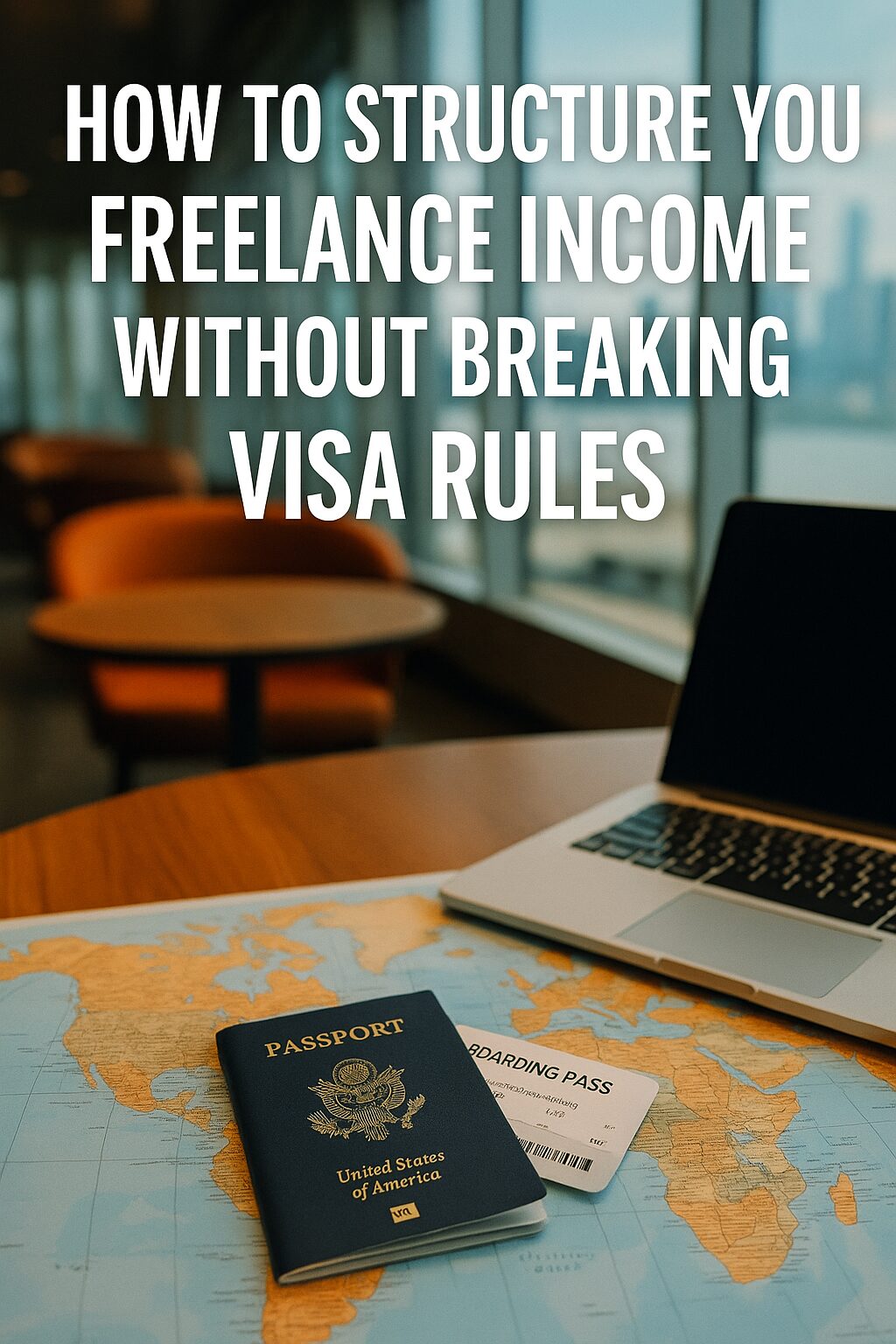Freelancing gives you freedom—but when you’re on a visa, that freedom comes with rules.
Many digital nomads, expats, and even U.S.-based freelancers unknowingly violate visa terms while working online.
The good news? With the right setup, you can structure your freelance income legally, protect your immigration status, and still grow your global career.
In this post, we’ll break down exactly how to earn freelance income without breaking visa rules—no matter where you are.
Why This Matters: Visa Violations Can Get You Banned
Freelancing on the wrong visa—or reporting income incorrectly—can result in:
- Visa denial or cancellation
- Deportation
- Permanent bans from reentry
- Loss of future green card or residency opportunities
Immigration agencies care how you earn and where you earn—not just that you’re making money. That’s why smart freelancers structure their income carefully.
Part 1: Understand What Your Visa Allows
Different countries and visa types have different rules. Here’s a simplified breakdown for some major categories:
✦ United States:
| Visa Type | Freelance Allowed? | Notes |
|---|---|---|
| F-1 (Student) | ❌ (unless OPT/CPT) | Must apply for OPT/CPT approval |
| H-1B (Worker) | ❌ (only for sponsoring employer) | No side gigs unless you get concurrent H-1B |
| O-1 (Extraordinary Ability) | ✅ | Must work in field of approval |
| E-2 (Investor) | ✅ | Must be for your registered business |
| B-1/B-2 (Tourist/Business) | ❌ | No paid work allowed |
| EB-2 NIW | ✅ | Can freelance if you self-sponsor & follow rules |
✦ Canada:
- Open Work Permit or PR: ✅
- Tourist visa: ❌
- Employer-specific visa: ❌ (unless freelance is part of job offer)
✦ UK:
- Global Talent Visa: ✅
- Tier 2 Worker Visa: ❌ (unless permitted by sponsor)
- Tourist Visa: ❌
Part 2: Define Your Freelance Structure – Safely
Here’s how to legally set up your freelance income:
1. Incorporate a Legal Entity (if needed)
If your visa allows you to run a business (e.g., E-2, O-1, PR), consider:
- U.S. LLC (Delaware, Wyoming, Florida)
- UK Limited Company
- Canadian sole proprietorship
Why it helps:
- Easier invoicing
- Tax separation
- Looks professional on visa applications
2. Use a Business Bank Account
Keep your personal and business finances separate. Immigration and tax officials like to see a clear divide.
Options for non-residents:
- Wise Business
- Payoneer
- Mercury Bank (US) – great for founders
- Revolut Business (EU)
Part 3: Choose Visa-Safe Payment Methods
Payment methods can make or break your compliance:
| Method | Visa-Safe? | Notes |
|---|---|---|
| PayPal Business | ✅ | Keep invoices and country origin documented |
| Stripe | ✅ | Needs linked entity (LLC, Ltd.) |
| Upwork/Fiverr | ✅ | Income history helps for visa proofs |
| Direct Wire Transfer | ⚠️ | May need to prove business origin |
📌 Avoid getting paid into personal accounts tied to countries where you lack tax residency—this creates red flags.
Part 4: Track and Report Income Properly
If you’re in the U.S. (or earning from the U.S.):
- Get an ITIN if you’re not a citizen/green card holder
- Use Form 1040-NR for tax filing
- Report all freelance income, even if paid from abroad
If you’re outside the U.S.:
- Follow your home country’s tax rules
- If on tourist visa, do NOT accept client payments locally
- Document income as foreign-sourced if possible
Part 5: Build a Visa-Safe Freelance Portfolio
Immigration officers prefer:
- Public websites (LinkedIn, Upwork, Fiverr Pro)
- Verified reviews
- Client contracts
- Screenshots of dashboards and earnings
- Tax records + invoice history
Create a “visa-ready” folder with:
- 3–5 client testimonials
- Income records
- Business formation documents (if applicable)
Part 6: Don’t Do This (Common Mistakes)
Mistake 1: Earning freelance income on a tourist visa
→ Illegal in almost all countries
Mistake 2: Getting paid into personal PayPal with no record
→ Raises tax and visa flags
Mistake 3: Using platforms with no documentation (Telegram, Discord gigs, etc.)
→ Hard to prove legitimate work later
Mistake 4: Accepting “under-the-table” payments
→ Can disqualify future visa or green card applications
Part 7: Best Practices for Freelancers on Visas
Always know your visa rules—get legal advice if unsure
Keep a monthly export of all invoices and payouts
Use platforms that give you proof
If you’re on a visa that bans work—wait, switch, or apply for an appropriate one
Treat yourself like a business: bank account, tax, contracts, records
Real-World Examples
O-1 Visa Holder (Graphic Designer):
Used Upwork Pro, LLC formed in Delaware, payment via Stripe, collected reviews + media mentions → O-1 approval + renewal
E-2 Visa Applicant (SEO Consultant):
Registered U.S. LLC, earned via Fiverr Pro + direct clients, documented all income → Approved E-2 investment visa
NIW Self-Petitioner (Data Analyst):
Freelanced on Upwork, created public portfolio + LinkedIn, used contracts + tax returns as evidence → EB-2 NIW granted
Conclusion
You don’t need to choose between making money and staying legal.
The key is structure.
By setting up your freelance business the right way:
- You protect your visa
- You avoid tax trouble
- You build a long-term international career
Your freelance income can be your biggest asset—or your biggest liability.
Structure it wisely.
